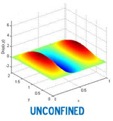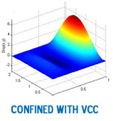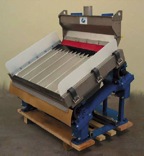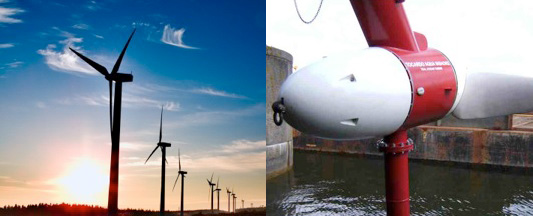Technology
Energy Management
Vibration Control by ConfinementTM (VCCTM)
 The VCC (Vibration Control by Confinement) approach to noise and vibration control and suppression problems is a groundbreaking technique that fundamentally changes how industry addresses the negative effects of excess noise and vibration energies. The VCC technology may be used to enhance quality of life, improve performance of consumer and industrial products, extend useful life of machinery and structures, and reduce the cost associated with the implementation of active control and smart technologies.
The VCC (Vibration Control by Confinement) approach to noise and vibration control and suppression problems is a groundbreaking technique that fundamentally changes how industry addresses the negative effects of excess noise and vibration energies. The VCC technology may be used to enhance quality of life, improve performance of consumer and industrial products, extend useful life of machinery and structures, and reduce the cost associated with the implementation of active control and smart technologies.
 Contrary to the current conventional passive and active vibration control approaches that are applied in time and/or frequency domains, our VCC method utilizes those domains plus the space domain in which spatial distribution of vibration energy is controlled. In other words, we control the flow of power by directing vibration energy away from the sensitive areas of the system. We have shown that if one can control and/or trap the vibration energy away from areas that are mission/performance/safety sensitive, then the excess energy can be more effectively removed. In some instances, the energy may remain in the trapped area if it does not affect the performance of the system. In other cases, the trapped energy can be removed more efficiently than conventional passive and/or active methods.
Contrary to the current conventional passive and active vibration control approaches that are applied in time and/or frequency domains, our VCC method utilizes those domains plus the space domain in which spatial distribution of vibration energy is controlled. In other words, we control the flow of power by directing vibration energy away from the sensitive areas of the system. We have shown that if one can control and/or trap the vibration energy away from areas that are mission/performance/safety sensitive, then the excess energy can be more effectively removed. In some instances, the energy may remain in the trapped area if it does not affect the performance of the system. In other cases, the trapped energy can be removed more efficiently than conventional passive and/or active methods.
The QRDc team has shown profound performance improvements by conventional vibrations control techniques when combined with VCC. For instance, we have demonstrated a 30% to 50% improvement in the performance of Constrained Layer Damping (CLD) when combined with VCC. We have also shown 80% to 98% improvement when conventional passive or active control techniques are enhanced with VCC. If VCC is applied as a stand-alone technique, it has unparalleled results.
The picture above demonstrates the VCC approach. The figure displays the basic process of what we refer to as the “Energy Steering and Shoveling Device.” This process takes place when we implement our smart energy-based vibration control technique. The key to our technique is that the excess energy is taken from the critical areas (sensitive interfaces) or critical modes and placed in the non-critical areas (non-sensitive interfaces) or non-critical modes. In doing so, some of the energy is also dissipated in various forms. Another way of looking at our energy managing concept is that we provide certain conditions in the structure so that it redirects its vibration energy from one place to another and from one mode to another mode. Our main contribution is the development of a smart structure which performs this steering and shoveling of energy by design, in a systematic manner, and most importantly, by controllable means. When energy management is induced, vibration energy is confined to a limited region within a structure. Consequently, the vibration energy injected into a structure by an external disturbance cannot randomly propagate away from its initial contact point with the structure but is directed to be confined, diverted, or trapped to selected regions.
One of the questions addressed by the VCC technology is whether it is possible to attenuate vibrations of the selected critical regions of a vibrating system to acceptable levels faster than its non-critical regions. Here, a critical region or a critical mode is defined with respect to a set of mission, safety, and performance criterion given in an application. Based on the VCC-based smart structure concepts with smart energy managing features, we will achieve significant noise and vibration reduction with a smaller amount of input energy than that consumed by commonly practiced controllers, thus enabling current and future actuators to perform more efficiently and effectively. Furthermore, our approach will result in a significantly less complex control system with a reduced cost when compared with current active vibration control systems.
Energy Flow ControlTM (EFCTM)
 Our Energy Flow Control approach to improve the sound transmission and vibration characteristics of a system is far more elegant and technologically advanced than conventional reactive solutions. It is a groundbreaking technique that fundamentally changes how industry addresses the negative effects of excess noise and vibration energy.
Our Energy Flow Control approach to improve the sound transmission and vibration characteristics of a system is far more elegant and technologically advanced than conventional reactive solutions. It is a groundbreaking technique that fundamentally changes how industry addresses the negative effects of excess noise and vibration energy.
EFCTM requires a detailed understanding of the modal response of the system to internal and external energy influences, and the application and management of mode localization. This requires a determination of the paths of energy flow within a given system or structure. To understand these energy flows, we develop computer models and tools that accurately measure and map energy responses on a systemic level. We test vibration energy management alternatives and arrive at efficient and economical solutions. Then passive, active or hybrid structural modifications are implemented to redirect, convert, divert, dissipate or confine excess troubling noise and vibration energy to structural regions where thy have minimal effect on the system. Simply stated, the excess and problematic vibration energy is simply steered or directed away from the critical sections of a system to achieve an efficient and economical solution to the skin or surface problem.
Contrary to conventional vibration control approaches, EFC may also be put to work to improve the efficiency of vibrating machinery. Examples of machines to EFC approaching include:
- Vibrating Mixers and Separators
- Vibrating Conveyors and Elevators
- Vibrating Compactors, Strengtheners, and Looseners
- Vibrating Crushers and Finishers
- Vibrating Bulk Material Handlers

QRDc’s patent-pending technologies for renewable energy generation offer the following benefits:
- Enhanced energy production
- Centralized wind power generation
- Significantly reduces turbine-generator maintenance cost
- Reduces turbine cost
- Reduces wind farm capital investment
- Scalable technology
- May be deployed to hydrokinetic generators
QRDc, Inc. has tapped SheerWind, Inc. to commercialize the wind power generation technology initially developed by the QRDC team. With the President’s goal of generating 80% of the nation’s electricity from clean energy by 2035, the country is in dire need of a leap-frog technology that can competitively extract energy from our green resources such as wind, solar, and geothermal. QRDc has developed and patented one such approach that reduce the cost of generating electricity from wind to below the current cost of the country’s least expensive conventional approaches.
Further information regarding this technology and its commercialization may be found at the SheerWind website: SheerWind.
